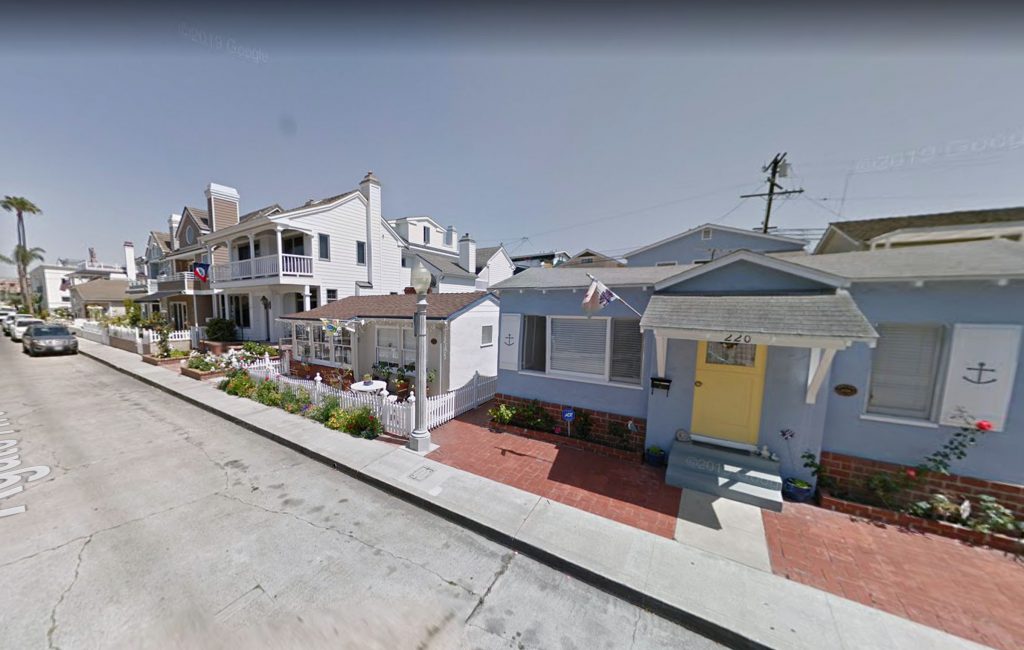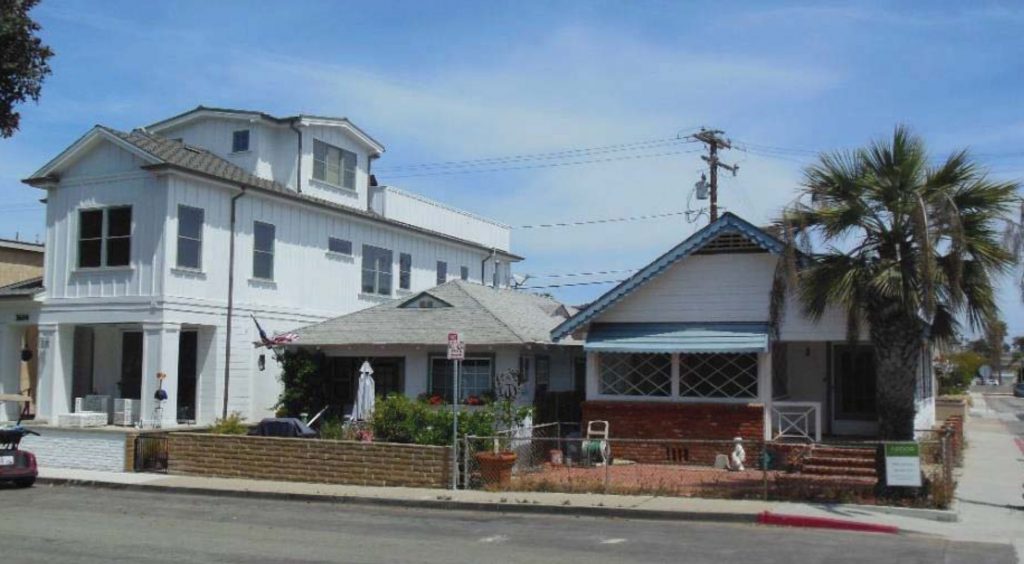
— Photo via Google street view
It could soon be easier for homeowners to remodel their small, older Newport Beach cottages, while still preserving their traditional character following the Planning Commission’s recent approval of an amendment to the city’s Cottage Preservation Code.
Commissioners voted 5-1 on Nov. 21 to move forward with the proposed changes. Commissioner Lauren Kleiman dissented. Commissioner Curtis Ellmore was absent.
The item also included an amendment to the Local Coastal Program.
It will go to City Council for review and, if approved, will head to the California Coastal Commission. It will return to Council for final adoption.
While not ideal, the amendment has several positive aspects and it’s a good start, a majority of commissioners agreed.
“Nothing is perfect in an ordinance,” Planning Commission Chair Peter Koetting said, echoing a comment from a public speaker. “So, it will change if we find there’s problems.”
Koetting said he spent time last week driving around specifically looking at this type of housing in town.
“There are so many different cottages,” he said. “This is the character of the community.”
This is an important step, Koetting added.
The recent recommendation was a revised version of the proposed amendment continued from Oct. 17. Staff incorporated changes to address the concerns raised at the hearing, including clarification about what type of projects the code would apply to, prohibition of short-term rentals, and limiting home additions.
The amendments will provide a voluntary option for homeowners seeking to remodel, but preserve traditional beach cottages, according to city staff.
Typically, cottages do not provide all the code-required parking and additions are limited to 10 percent of the existing floor area. The amendments would allow larger additions (up to 50 percent of the existing floor area or 500 square feet, whichever is greater) without providing the minimum code-required parking when the project would result in the preservation of the cottage’s character and a building envelope that is representative of traditional development patterns in the City. Eligible projects would also receive relief from a building code valuation threshold requiring building code compliance as new construction.
A concern raised at the previous meeting was that the proposed 50 percent addition could result in some pretty large cottages, Principal Planner Jaime Murillo explained.
City staffers’ intent was to develop an ordinance that would apply to a wide variety of situations, he noted. The 50 percent addition is needed for the small cottages, so staff suggested a cap of 500 square feet to limit larger additions.
“At the end of the day, they still have to fall within that prescribed building envelope, so that’s an additional constraint that may limit the size of the potential addition,” Murillo explained.

— Photo via Google street view
Most of the Commissioner’s discussion revolved around whether they should increase staff’s recommended maximum of 500 square feet to 750 square feet.
It doesn’t have to be a finite number at this point, staff confirmed. Ultimately, they incorporated it as an option within the recommendation to City Council.
In explaining her dissenting vote, Kleiman noted that she understood staffers’ recommendation and that it’s trying to address the general interest of residents to maintain “old Newport” versus the “new Newport” or new development.
“However… I think that ship has sailed,” Kleiman said. “And unless we are going to totally overhaul our development standards, I think this is putting a band-aid on something in a way that’s not practical.”
It’s very limited in its application, she noted. It won’t address the concerns of residents, many of whom don’t want to see any change at all, she opined.
“I understand the spirit of this, but the practical application is where I think it will fall short,” Kleiman concluded.
Although the handful public speakers disagreed. Most of the people with these cottages, particularly those on Balboa Island, are in support of the amendment, several residents agreed.
Longtime Island local Tom Houston was on board with the idea.
“If you want a 10,000-square-foot house, go down the road a bit,” he said. “Why not try and keep some of the charm (in older neighborhoods)?”
Nothing is perfect and there might be some mistakes and might be a “band-aid,” but it’s a very logical improvement to the massive new/redevelopment going on in small communities around the city, Houston said. It’s a “heck of an incentive” to try and stop huge houses from being built.
“This is a step in the right direction,” Houston said.
Julie Lucky, who owns a 1938 Newport Beach home, said the small houses lack space for storage, modern appliances and furniture, laundry is often placed in the garage, which reduces parking space, and home offices “were not a thing” when the structures were built.
“I understand the challenges of living in an old home,” she said. “Since many of the beach cottages weren’t built for year-round living, it’s a challenge to adapt them to accommodate today’s needs. And it looks like this amendment will enable that.”
It’s understandable why so many of her neighbors are tearing down their homes and rebuilding, but preserving the remaining cottages is important for maintaining the character and charm of the community, Lucky noted.
Jim Maloney, who has lived in Newport Beach the past 20 years, owns two older cottages on the Balboa Peninsula and Balboa Island. Both homes are under 1,000 square feet.
These small homes don’t have an attic or basement, so the garages become de facto storage and laundry rooms, he explained. Residents then park their cars on the street.
“That’s just a fact of life,” Maloney said.
When homeowners consider remodeling, they are looking at how to make the small cottages livable, he explained.
The amendments come as a result of growing community concerns related to the loss of small residential cottages and the bulk and mass associated with new single- and two-unit dwelling developments, Murillo explained. Following an April 23 study session, Council directed staff to return with a resolution to initiate code amendments to address these concerns, including incentivizing cottage preservation.
City staffers acknowledge it’s challenging to determine what houses are considered cottages.
“There is no definition that accurately describes what constitutes a cottage,” the staff report reads. “However, as used by the community, the term cottage refers to the smaller residential dwellings or structures that are representative of the traditional development patterns in the city, particularly in old Corona del Mar, Balboa Island, and the Balboa Peninsula.”
They are typically one-story, with the exception of a small second story above parking in the rear of a lot. They vary in architectural style and year of construction.
It’s a difficult question and there’s not one architectural style that defines these cottages, Murillo said.
“Therefore, for the purpose of this amendment, the cottage preservation incentive will be granted for those projects that agree to maintain a building envelope representative of traditional cottages,” staff explained in the report.




